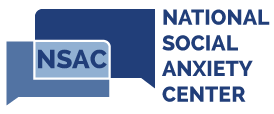March 3, 2025
Dear Colleagues,
The National Social Anxiety Center (NSAC) provides information about relevant and current research in service of disseminating and promoting evidence-based treatment. This month’s summary is written by Hsiao-ching Chu, PsyD, A-CBT, DBT-LBC, representing NSAC Avon, CT and examines the 2023 article “Role of Parenting and Psychosocial Correlates Contributing to Social Anxiety in Asian Adolescents: A Systematic Review” by Ilyas & Khan.
The present systematic review study aimed to explore social anxiety and associated factors in adolescents in Pakistan, India, and China. It was conducted per methodology outlined by the Preferred Reporting Items for Systematic Reviews and Meta-Analyses (PRISMA) guidelines. A pool of 50 articles published from 2012 to 2022 was established. The researchers found that social anxiety was directly related to authoritarian parenting, interbrain synchrony between parents and adolescents, low self-esteem, low quality of life, lower emotional intelligence, and higher activity in the amygdala of the brain. Some of the interpretations of their findings are as follows:
Social anxiety and parenting style. According to the authors, social anxiety and parenting style shows a significant relationship. The results suggest that authoritative parenting does not correlate with social anxiety in adolescents, despite the fact that it is positively connected with social-emotional difficulties. Conversely, authoritarian parenting is significantly correlated with high levels of SAD in adolescents.
Authoritative parents tend to demonstrate a more mindful parenting style. Parents are responsive and sensitive to the needs of their children. According to the authors, authoritative parenting is characterized by a close, nurturing relationship between parents and children. Parents set clear expectations and guidelines and explain the reasoning behind their disciplinary actions. They use disciplinary methods as a supportive tool rather than as punishment. A high level of tenderness paired with a high level of discipline seems to shield adolescents from worries, while also promoting the growth of cognitive ability, social skills, and self-control.
Authoritarian parents tend to be less nurturing and maintain high expectations with limited flexibility. They overuse punishment as the main tool of discipline. Parents establish strict rules without any explanations, and the child is expected to follow without question or negotiation. Such inflexible child rearing practices has a high concordance with early onset of psychopathology. According to the authors, these strict and demanding behaviors from parents can lead to the development of insecurities, loss of confidence, and social withdrawal. Moreover, punitive and overcritical parenting is associated with predisposing and perpetuating factors of SAD and other anxiety disorders. Finally, the factors that affect social anxiety due to parenting can also be caused by familial attitudes (e.g., rejection, hostility, emotional distancing, and negative beliefs about the world).
Social anxiety and neural activity of the brain. During social interactions, neural and behavioral processes coordinate. According to the findings, the gray matter volume (GMV) of the orbitofrontal cortex (OFC) and the functional connectivity of the OFC with the amygdala are both positively correlated with social anxiety. People with SAD have increased OFC activation when confronted with stressful situations. Adolescents with SAD appeared to require greater engagement from the OFC in order to control their fear responses. In essence, social anxiety can be determined by an overactive fear-processing circuit response to threats.
Social anxiety and interbrain synchronization in parent-adolescent pairs. According to the authors, the first instance of a child’s social interaction occurs when the child and parent’s biological rhythms and social cues synchronize in their brains. Such interbrain synchrony was a sensitive marker of social-emotional interaction. In social situations, parents and adolescents send out social indications through their behaviors, facial expressions, and postures.
In one study, the parent-adolescent dyads were exposed to picture processing stimuli. Under favorable conditions, parent-adolescent pairs in the high social anxiety group showed greater gamma interbrain synchronization than parent-adolescent pairs in the low social anxiety group. However, under adverse conditions, parent-adolescent pairs in the low social anxiety group showed greater gamma interbrain synchronization than parent-adolescent pairs in the high social anxiety group. These findings offer neurobiological evidence that the anxiety level of the adolescent may have an impact on how the parent and adolescent experience various emotions during the same emotional episode.
Social anxiety and self-esteem. Low self-esteem causes people to focus excessively on criticism and be more sensitive to rejection in social situations. Conversely, high self-esteem makes it easier for people to generate accurate explanations for how they were seen negatively in social situations and makes them less prone to worry. The findings of different studies included in this review show that there is no gender difference among adolescents in the relationship between social anxiety and self-esteem.
Social anxiety and emotional intelligence. Adolescents with severe social anxiety exhibit deficiencies in emotional expression and have a higher level of emotional suppression than adolescents without such difficulties. Social anxiety was also linked to ineffective emotional regulation and dysfunctional emotional control. Adolescents with high levels of social anxiety and self-focused attention are more likely to be aware of their emotional reactions, which makes them feel more self-conscious and causes inhibitory responses in social interactions and relationships. Adolescents with stronger emotional intelligence have better emotional regulation and are less likely to experience social anxiety.
For clinicians:
1. How can we utilize and incorporate some of these findings into our treatment and clinical approach?
2. How might these findings inform parent training approaches with socially anxious youth?
Ilyas, U, & Khan, SD (2023). Role of parenting and psychosocial correlates contributing to social anxiety in Asian adolescents: A systematic review. Innovations in Clinical Neuroscience, 20(7-9), 30–36.
____
Hsiao-ching Chu, PsyD, A-CBT, DBT-LBC
Representing NSAC Avon, Connecticut
(Cognitive Behavioral Services of Connecticut)
